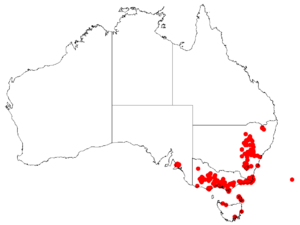Bushy Needlewood facts for kids
Quick facts for kids Bushy Needlewood |
|
|---|---|
 |
|
| H.decurrens subsp. physocarpa | |
| Scientific classification | |
| Genus: |
Hakea
|
| Species: |
decurrens
|
 |
|
| Occurrence data from AVH | |
Hakea decurrens, commonly known as bushy needlewood, is a species of shrub or small tree. It belongs to the plant family Proteaceae.
What Does It Look Like?
Hakea decurrens can be a small bush or a tree. It usually grows between 0.4 and 5 meters (1.3 to 16 feet) tall. Its smaller branches can have soft, silky hairs. Sometimes these hairs disappear as the plant grows.
The leaves of this plant look like needles. They spread out wide and are usually 1.5 to 8 centimeters (0.6 to 3.1 inches) long. They are also quite thin, about 0.7 to 1.6 millimeters (0.03 to 0.06 inches) wide. The leaves are smooth and have a groove on their underside. Each leaf ends with a sharp point.
This plant produces many flowers from May to September. The flowers are white or pink. They grow in groups of 1 to 6 in the leaf corners. Each flower grows on a short stalk that can be white or rusty in color. This stalk might have a few hairs or be very hairy.
After the flowers, the plant grows grey, woody fruits. These fruits are shaped like an egg. They are about 1.8 to 3.5 centimeters (0.7 to 1.4 inches) long and 1 to 3 centimeters (0.4 to 1.2 inches) wide. The fruits have clear bumps or "warts" on them. They also have a noticeable beak with two small horn-like parts.
How It Got Its Name
The plant Hakea decurrens was first officially described in 1830. This was done by a botanist named Robert Brown. He wrote about it in a book called Supplementum primum prodromi florae Novae Hollandiae.
The second part of its name, decurrens, is a Latin word. It means "decurrent" or "prolonged below the point of insertion." This describes how the leaf attaches to the stem.
In 1996, another botanist, William Robert Barker, studied Hakea decurrens more closely. He found that there are three slightly different types, called subspecies. These subspecies are now officially recognized.
The main ways to tell these subspecies apart are by their fruit and the hairs on their younger branches.
- Hakea decurrens subsp. decurrens: Its younger branches have flat hairs that soon become smooth. Its fruit is 1 to 1.8 centimeters (0.4 to 0.7 inches) wide.
- Hakea decurrens subsp. platytaenia: This type has hairs that stay raised. Its fruit is larger, 2.6 to 3.5 centimeters (1 to 1.4 inches) wide.
- Hakea decurrens subsp. physocarpa: Its branches have flat hairs that fall off quickly. Its fruit is 1.3 to 2.5 centimeters (0.5 to 1 inch) wide.
Where Does It Grow?
Hakea decurrens is a plant that naturally grows in Australia. You can find it widely across New South Wales, Victoria, and Tasmania. It has also started growing in other places where it wasn't originally found, like South Australia and Portugal. When a plant starts growing in a new area, it is called "naturalised."
The three subspecies grow in different areas:
- H.decurrens subsp. decurrens: This type grows on the western slopes and plains of the Great Dividing Range in New South Wales.
- H.decurrens subsp. platytaenia: You can find this subspecies in exposed coastal areas in southeastern New South Wales, eastern Victoria, and the Bass Strait Islands.
- H.decurrens subsp. physocarpa: This subspecies grows in New South Wales, Victoria, and the Bass Strait Islands. In Tasmania, it is thought to be native in the north. However, it has become naturalised in the south. It is also naturalised in the Mount Lofty Ranges in South Australia and in Portugal.


